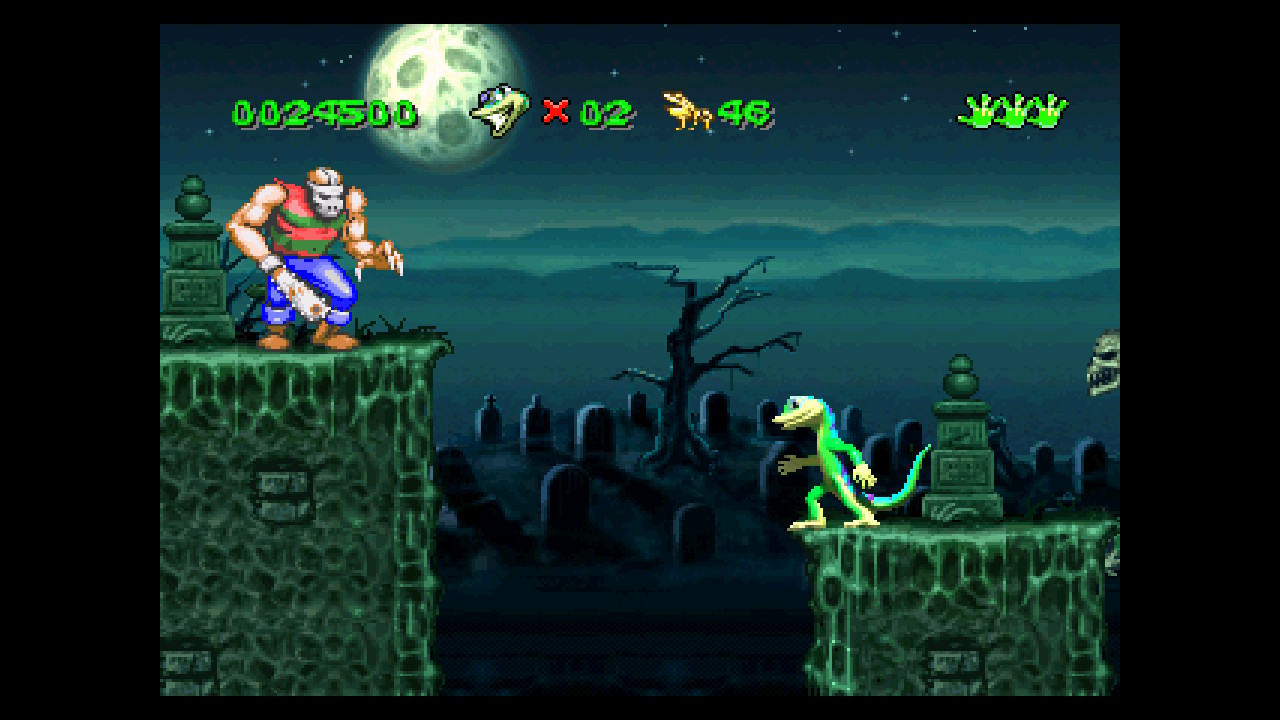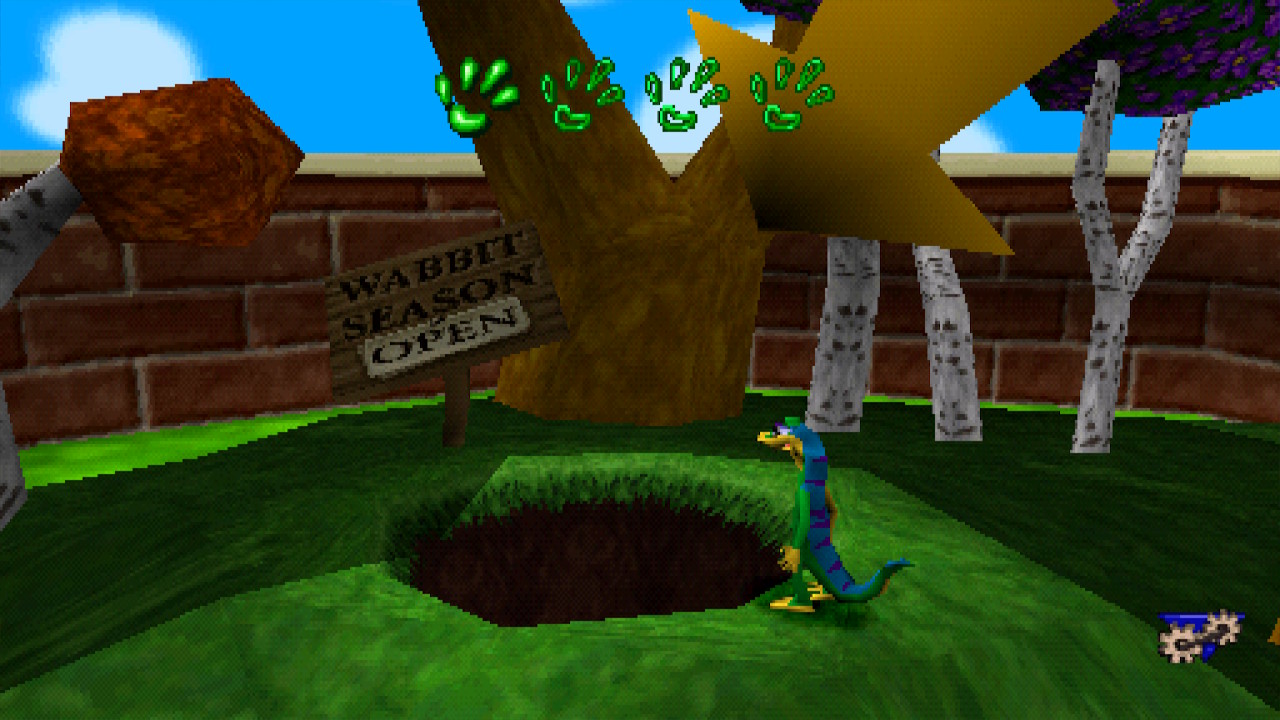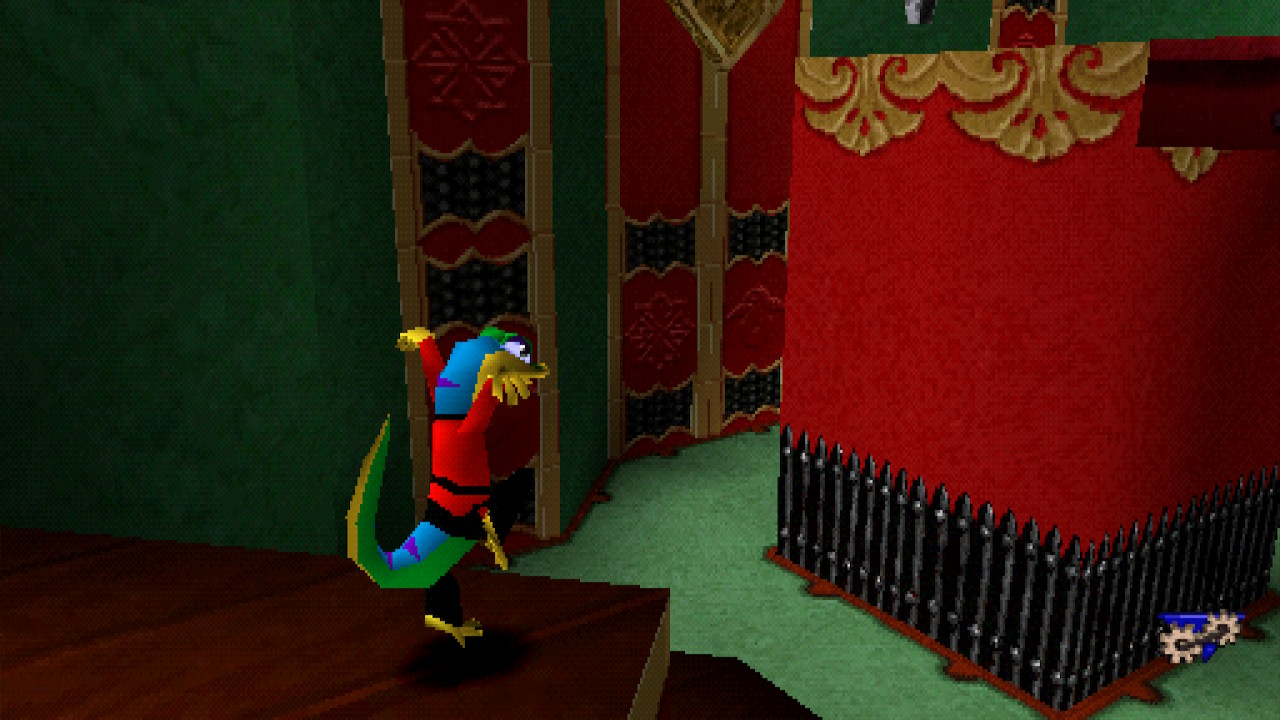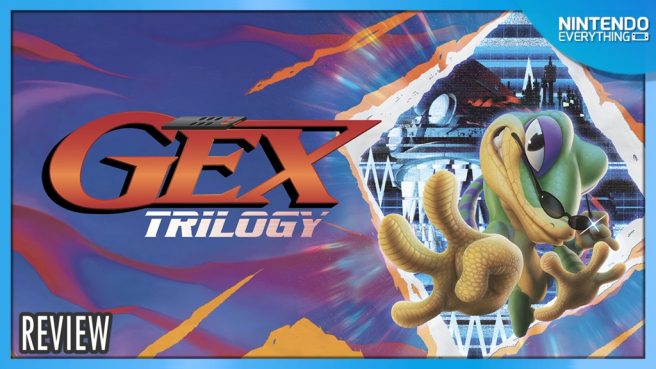System: Switch
Release date: June 15, 2025
Developer: Limited Run Games / Crystal Dynamics
Publisher: Limited Run Games
The Gex series is one that has been out of the limelight for a long time. While seen as unique and unconventional in his pomp, Gex has faded into obscurity. The gecko is best known these days as a bit of an internet meme, seen more in the ilk of Bubsy than of Sonic or Crash Bandicoot. Even still, the character had several big-time game releases and was the poster boy for Crystal Dynamics for quite a while, and that team has gone on to make some truly brilliant titles. Over time, the franchise has become increasingly less accessible, and so people who may want to try out Gex’s titles to see if maybe time has treated him too harshly. Thankfully, Limited Run Games has seen that cult desire for the wise-cracking TV addict to make a comeback, and have obliged with a trilogy collection of three adventures with the very first entry plus Gex: Enter the Gecko and Gex 3: Deep Cover Gecko. In the past, I had only played Gex 2, and I was very young at the time, so when this collection was announced, I was very excited to play it again, as well as what came before and after. How do they hold up nearly three decades later?
The plot of the original Gex title is as straightforward as it gets: Gex the Gecko is a literal lounge lizard, sitting on a large family inheritance, he spends his days watching nothing but telly and films. One day, an evil mastermind by the name of Rez decides he wants Gex as his new mascot character, and thus sucks Gex into his television set and lands him in a place known as The Media Dimension. Here, Gex needs to use his vast TV and film knowledge to get through the different worlds, defeat Rez and make it back home. While the plot is unremarkable, the cutscenes are quite entertaining and pretty impressive for the time of release.
Now, unlike the two sequels that followed it, the original Gex game is actually a 2D platformer. In this game, Gex has to make it to the end of each level and also find within it, a TV remote. These are vital for progression, as with each one he finds, he gains access to another level within The Media Dimension. Simply finishing the stage won’t unlock the next one. There are five different worlds for Gex to traverse through, and several boss fights for him to take on in his efforts to beat Rez and make it home. In terms of abilities, Gex utilizes all his skills as a gecko to the fullest; including using his tongue to grab far-reaching items, climbing on walls along the stage as well as in the background, and whipping enemies with his tail as well as bouncing on them, a little bit like Scrooge McDuck in the NES DuckTales game. He can dash quite quickly when the player holds the run button down. Within stages are also power-ups that can help the gecko on his quest, including speed up, invincibility, flame and ice breath, amongst other things. Outside of TV remotes, Gex can also collect bugs to munch on, and upon finding one hundred critters, he gets another life. In each level, Gex opens with three hit points, and if he is hurt three times, he loses a life. Checkpoints exist within levels, so should your gecko meet his demise, he can jump right back into the fray to try again. There are certain items Gex can pick up to replenish his hit points, and in fact, there are some that can extend those hit points to a maximum of 6.

Gex can also find video tapes in levels with passwords on them to save your progress, but thanks to this new collection; the player can save their progress by pressing down the right control stick (R3), as this opens up a new menu available in all three games, where you can save progress on three different files, load saves, change the screen filter, change screen size, and other helpful quality-of-life additions. This was very welcome, and a fantastic decision from the developers, as the original trilogy still operated on the password system. All titles support full screen and control stick support too, for the first time in Gex 1’s case.
I really like Gex 1 – it is a solid, fun platformer with unique visuals and challenging gameplay. I do think the abundance of bottomless pits gets quite egregious in the latter half of the adventure, and the boss fights can be a little too easy with a relatively forgettable soundtrack, but I’m grateful I got the opportunity to finally play it; I am happy to give it a thumbs up.
Now, there is something I haven’t mentioned about Gex yet that will heavily impact your enjoyment of his titles; he talks. A lot. You will find his constant jabbering either charming or infuriating, and I don’t think there is much of an in-between. Maybe because I see a little of myself in him, I quite like Gex. You will hear him reference Scooby-Doo quite a bit in the first world. Anything from pop culture is game; he does a Rocky impression, he references Elvis no longer being with us-even TV commercials aren’t safe from his repertoire of gags. Dana Gould voices him in all three games in the USA. I grew up with a different voice in Gex: Enter the Gecko (which Limited Run Games has said will be patched in as an option in a future update), so his voice was unfamiliar to me, but I found him quite funny. His line deliveries are varied, and although I might not get everything he’s saying, the gags are wackily delivered enough it made me crack a smile anyway.

In Gex: Enter the Gecko, Rez is back, and the US government enlists our hero to return to The Media Dimension to finish him off once and for all. After some contract negotiations, he agrees to get back into action, and this time he’s going 3D. Now an official spy for the nation, Gex makes his way through some new worlds as well as some that are similar to the first game; he’s also picked up a few new tricks – one of which is a flying kick akin to Bruce Lee’s that he can trigger from a run and crouch button combination. It is still tail time, and Gex’s catchphrase still holds true, as in 3D your main method of attacking is still tail whipping and bouncing off enemies. Each world has unique collectible items as opposed to just bugs like in Gex 1; in the Chinatown level, he collects Chinese takeout cartons and Yin/Yang logos; in the Looney Tunes-style world, you get carrots and TNT. However, just like Gex 1, TV remotes are still the aim of the game for progression. This time each level is done in a mission select style, like choosing a star to attempt collecting in Super Mario 64. These are red remotes; and the criteria for earning them is different for each mission. It can be finding a certain number of items, defeating particular enemies, or reaching the end of the level. These are mandatory if you want to face off with Rez. There are also optional silver and gold remotes. Silver remotes are hidden in levels, and gold remotes can only be earned in bonus rounds found within worlds.
Gex’s move list in Gex 2 is noticeably simpler; he can no longer cling to almost all surfaces-there are only specific walls within levels he can climb along. The power-up bugs also don’t return from the first title, so no flame breath or super jumping here. Gex: Enter the Gecko is a simple but playable 3D platformer that largely rides on the charisma and charm of its worlds and its main character. Gex has a lot more jokes this time around, and the enhanced sound only adds to Dana Gould’s already good performances from the previous game. While this experience has less depth of gameplay than the titles that came before and after it, there’s enough here to warrant a playthrough and it deserves its place in this collection. This game was one that I played in widescreen and I had a fun time playing it and taking Rez down once again.

Yet still, that nefarious Rez has come back to bother Gex again-this time, for revenge! In Gex 3: Deep Cover Gecko, Gex has to return to The Media Dimension once more in order to save his fellow government operative Agent Xtra (played in live action by Baywatch’s Marliece Andrada) from Rez’s evil clutches. Now with his own Not-Batcave hub world to enter different levels with, Gex 3 follows a similar format to Gex 2, but this time around, the overworld outside the main stages have been significantly expanded to include items and platforming challenges within them, and while this may seem like a small change, it adds a lot of depth to the experience and life to the world. Gex 2’s worlds often felt like there was a lot of empty spaces, and this certainly held through for the hub world you accessed stages in, but that isn’t the case in Gex 3, and it is something to be commended. Another improvement from the previous game is the 3D camera control, which is a lot easier to manipulate and a lot more useful in finding different items and collectibles. Crystal Dynamics obviously felt the same away about Gex feeling a tad more limited in Gex 2, because a lot of elements from the original Gex return here; including the traditional collectible bugs rather than a bunch of different items, and fire and ice breath power-ups return too. Gex’s animations have also seen an upgrade. He had level specific animations in the second game, but in Gex 3, this is cranked up to 11 and he is full of personality. Now his actions match up with his motor-mouth, and more of his charm shines through.
I think that Gex 3: Deep Cover Gecko is an improvement all around the board. Stages are better, the hub world is better, Gex has more style and abilities than before, and the mission structure is streamlined too. Gex 2 was a solid base, and Gex 3 built on It so well that I think this game is the definitive Gex experience-Combining the best elements of both previous titles to make something I would classify as legitimately great. My only gripe with the game-and it is small-is that sometimes the game’s frame rate will drop and the game will slow down because so much is going on at one time; it was pushing the PlayStation’s limits. This small issue is something I’ll have to note in my overall thoughts on this collection: this trilogy cannot be looked at as a set of remasters, because they are not. These are the original three Gex titles as they were released, with some quality-of-life changes for modern play. As I mentioned earlier, the saving and different display and filter options, as well as analogue control are welcome additions, but these changes don’t fix the inherent issues these games have. Additional features for this collection include a jukebox mode featuring all three games’ soundtracks, the trilogy’s instruction manuals, and a gallery with a lot of Gexcellent artwork. There are also trailers for the games included here, including a very funny Scream spoof promoting Gex 2, interviews with Gex’s voice actor Dana Gould (with appearances from his very cute dog!), and rare footage of the cancelled Gex title: Gex Jr. This is all very cool stuff and add genuine value to this collection.
Gex Trilogy is a fun collection of three decent platformers that deserve the spotlight. While I would have liked Limited Run Games to go in and individually improve each title’s flaws rather than providing one set of options for all three games, these improvements are welcome, and the extras for this package make it a must-have for Gex’s fellow lounge lizards out there. I do think the price may be a little high for what is on offer-especially for three titles which haven’t been remastered but rather given enhanced ports-these games have been faithfully restored and on those merits deserve to be played. This collection is worth a go if you are even the teensiest bit curious about why, at one point, people couldn’t get enough of Gex-even if he quotes Austin Powers just a little bit too much.
Gex Trilogy copy provided by the publisher for the purposes of this review.

